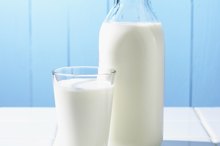What Is the Difference Between Vitamin D Milk & 1% Milk?
All types of cow's milk you're likely to find at the local supermarket are fortified with vitamin D; it doesn't occur naturally in any of them. Vitamin D and others, including vitamin A, are added to much of the milk available in the United States during processing, also known as fortifying. Some milk companies have replaced the "whole milk" label with "vitamin D milk," which may be a bit misleading.
Fat Content
Vitamin D milk sometimes is labeled as whole milk, and there are some differences between it and 1 percent milk -- including the fat content. The amount of fat contained in different types of milk is what separates them from each other. When milk is labeled 1 percent, this means that the milk contains less than 1 percent fat, whereas whole milk, also labeled as vitamin D milk, contains 3.5 percent fat, the Dairy Council of California explains on its website.
Difference in Calcium
How Many Calories Does a Chai Tea Latte Have?
Learn More
Milk is a good source of calcium, which helps build healthy and strong bones. Both 1 percent and whole milk contain calcium, but 1 percent milk contains more than other types. The Dairy Council of California reports that an 8-ounce serving of 1 percent milk offers 380 milligrams of calcium to 301 milligrams per serving for whole milk.
- All types of cow's milk you're likely to find at the local supermarket are fortified with vitamin D; it doesn't occur naturally in any of them.
- When milk is labeled 1 percent, this means that the milk contains less than 1 percent fat, whereas whole milk, also labeled as vitamin D milk, contains 3.5 percent fat, the Dairy Council of California explains on its website.
More or Less?
With higher fat content comes more calories per serving, so it isn’t surprising that whole milk contains 156 calories in each 8-ounce glass to 127 calories for 1 percent milk. The low-fat milk also contains 2 grams more protein per serving than whole, close to 100 milligrams more potassium and 3 grams more fiber.
Vitamin D Amounts
Almond Milk vs. Skim Milk
Learn More
While there are differences in fat, calories and other nutrients, the amount of vitamin D added to the various types of milk remains the same. In an 8-ounce serving of 1 percent milk, you get 25 percent of your daily recommended amount -- the identical amount in an 8-ounce serving of whole or vitamin D milk. So if you’re looking to cut calories or fat while still getting your vitamin D fix, 1 percent milk might be the best choice for you.
Related Articles
References
- Dairy Council of California: Types of Milk
- Dairy Council of California: Milk
- Milk, reduced fat (2%). FoodData Central. U.S. Department of Agriculture. Published April 1, 2019.
- Månsson HL. Fatty acids in bovine milk fat. Food Nutr Res. 2008;52. doi:10.3402/fnr.v52i0.1821
- Wadolowska L, Sobas K, Szczepanska JW, Slowinska MA, Czlapka-Matyasik M, Niedzwiedzka E. Dairy products, dietary calcium and bone health: possibility of prevention of osteoporosis in women: the Polish experience. Nutrients. 2013;5(7):2684-707. doi:10.3390/nu5072684
- Varenna M, Manara M, Galli L, Binelli L, Zucchi F, Sinigaglia L. The association between osteoporosis and hypertension: The role of a low dairy intake. Calcif Tissue Int. 2013;93(1):86-92. doi:10.1007/s00223-013-9731-9
- Cormick G, Ciapponi A, Cafferata ML, Belizán JM. Calcium supplementation for prevention of primary hypertension. Cochrane Database Syst Rev. 2015;(6):CD010037. doi:10.1002/14651858.CD010037.pub2
- National Cancer Institute. Calcium and cancer prevention. Updated May 4, 2009.
- Radavelli-Bagatini S, Zhu K, Lewis JR, Dhaliwal SS, Prince RL. Association of dairy intake with body composition and physical function in older community-dwelling women. J Acad Nutr Diet. 2013;113(12):1669-74. doi:10.1016/j.jand.2013.05.019
- Josse AR, Tang JE, Tarnopolsky MA, Phillips SM. Body composition and strength changes in women with milk and resistance exercise. Med Sci Sports Exerc. 2010;42(6):1122-30. doi:10.1249/MSS.0b013e3181c854f6
- Rautiainen S, Wang L, Lee IM, Manson JE, Buring JE, Sesso HD. Dairy consumption in association with weight change and risk of becoming overweight or obese in middle-aged and older women: a prospective cohort study. Am J Clin Nutr. 2016;103(4):979-88. doi:10.3945/ajcn.115.118406
- Flom JD, Sicherer SH. Epidemiology of cow's milk allergy. Nutrients. 2019;11(5). doi:10.3390/nu11051051
Writer Bio
Jeff Herman began his journalism career in 2000. An experienced, award-winning sportswriter, his work has appeared in "The Washington Post," "ESPN the Magazine" and the "Boston Herald," among other publications. Herman has a Bachelor of Arts in journalism from West Virginia University.









